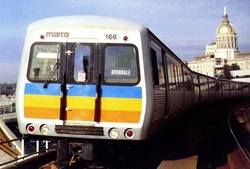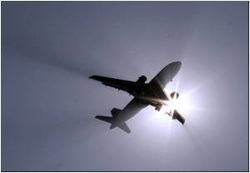MARTA

We interviewed a MARTA employee and this is how it went:
1) Do trains give off any emissions? If so what kind of emissions and how much?
MARTA trains are “electrically powered” vehicles and there are no emissions produced. Non-electrically powered trains such as diesel locomotives do give off emissions.
2) What type of energy powers the trains and how much energy is used per train?
Trains are electrically powered from a 750Vdc energized third rail system. Rail cars have collector paddles that ride atop the energized third rail. Energy is transferred from the third rail to the rail car propulsion system (electric motor).
3) Who supplies MARTA's energy or fuel?
For rail cars, rail stations and facilities, the local electrical utility is Georgia Power (Southern Company). Power is typically delivered to MARTA property at substations at 19.8Kv AC.
4) How is the energy you receive produced?
The energy received from Georgia Power is produced primarily from coal-fired power plants or nuclear power plants in Georgia.
5) How much money does it cost to fuel the trains?
The daily cost in electrical energy to propel all MARTA trains is approximately $21,000 per day. For most of the day there is are 144 rail cars operating (24 trains = 21- 6 car trains + 3 - 2 car trains) for approximately 22 hours per day. However, the trains depend on other track related equipment such as signals and switches to operate. The rail stations also require power for lights, fare gates, elevators and escalator etc. So the total cost per day rail cars and stations combined is approximately $37,100 per day.
6) How much money does it take to maintain trains, railways, and stations?
The budget for rail operations is $125,836,799.00 of which $25,935,564.00 is budgeted to maintain the rail cars.
7) How many trains does MARTA have?
MARTA has 338 rail cars. Rail cars are connected together in pairs (multiples of two) to make 2-car, 4-car, 6-car or 8-car trains. Most trains on the MARTA operate as six (6) cars.
8) How many buses does MARTA have?
505
9) What is the mileage of the buses?
Our 40 and 35 foot buses get between 2.5 and 4.0 MPG. Our Clean Diesel buses use approximately 115 gallons of diesel and our Compressed Natural Gas (CNG) buses use between 12092 and 23065 std. cu. Ft @ 3600psi.
10) In total, how many miles do your buses drive combined daily?
Approximately 1,000 route miles per day.
11) Do you know how much and what kind of emissions are given off daily or monthly by your buses? (this can be for one bus or all of your buses)
MARTA operates 158 full size clean diesel buses and 347 “clean-fuel” Compressed Natural Gas (CNG) buses, which reduce carbon monoxide by a full 95%.
1) Do trains give off any emissions? If so what kind of emissions and how much?
MARTA trains are “electrically powered” vehicles and there are no emissions produced. Non-electrically powered trains such as diesel locomotives do give off emissions.
2) What type of energy powers the trains and how much energy is used per train?
Trains are electrically powered from a 750Vdc energized third rail system. Rail cars have collector paddles that ride atop the energized third rail. Energy is transferred from the third rail to the rail car propulsion system (electric motor).
3) Who supplies MARTA's energy or fuel?
For rail cars, rail stations and facilities, the local electrical utility is Georgia Power (Southern Company). Power is typically delivered to MARTA property at substations at 19.8Kv AC.
4) How is the energy you receive produced?
The energy received from Georgia Power is produced primarily from coal-fired power plants or nuclear power plants in Georgia.
5) How much money does it cost to fuel the trains?
The daily cost in electrical energy to propel all MARTA trains is approximately $21,000 per day. For most of the day there is are 144 rail cars operating (24 trains = 21- 6 car trains + 3 - 2 car trains) for approximately 22 hours per day. However, the trains depend on other track related equipment such as signals and switches to operate. The rail stations also require power for lights, fare gates, elevators and escalator etc. So the total cost per day rail cars and stations combined is approximately $37,100 per day.
6) How much money does it take to maintain trains, railways, and stations?
The budget for rail operations is $125,836,799.00 of which $25,935,564.00 is budgeted to maintain the rail cars.
7) How many trains does MARTA have?
MARTA has 338 rail cars. Rail cars are connected together in pairs (multiples of two) to make 2-car, 4-car, 6-car or 8-car trains. Most trains on the MARTA operate as six (6) cars.
8) How many buses does MARTA have?
505
9) What is the mileage of the buses?
Our 40 and 35 foot buses get between 2.5 and 4.0 MPG. Our Clean Diesel buses use approximately 115 gallons of diesel and our Compressed Natural Gas (CNG) buses use between 12092 and 23065 std. cu. Ft @ 3600psi.
10) In total, how many miles do your buses drive combined daily?
Approximately 1,000 route miles per day.
11) Do you know how much and what kind of emissions are given off daily or monthly by your buses? (this can be for one bus or all of your buses)
MARTA operates 158 full size clean diesel buses and 347 “clean-fuel” Compressed Natural Gas (CNG) buses, which reduce carbon monoxide by a full 95%.
Aviation

It is assumed that the aviation industry contributes lots of dangerous
chemicals to the air. It is true. However, compared to other industries,
these dangerous chemicals are only 3.5% of the world’s scale (Australian
Academic of Science, 2011). Unlike car industries that have much new
technological advancement to limit their emissions, in the aviation
industry, such technology is still hard to find. For instance, it has
been taking years for the industry to come up with Bio-solar jet fuel;
however, the implementation of this technology is still minimum, as
costs are the biggest concern in this matter. The most common kinds of pollution by planes are air and noise pollution (http://aviationknowledge.wikidot.com/aviation:polltuion, 2011) (http://www.medindia.net/news/Noise-from-Air-Road-Traffic-can-Raise-Blood-Pressure-Even-While-Sleeping-32936-1.htm, 2011).
It is hard to talk about how to improve aviation pollution when professionals can't produce results. Just a few ideas would be for government to set aside money for research to improve aviation pollution and to focus on reducing emissions rather than alternative fuels.
It is hard to talk about how to improve aviation pollution when professionals can't produce results. Just a few ideas would be for government to set aside money for research to improve aviation pollution and to focus on reducing emissions rather than alternative fuels.
